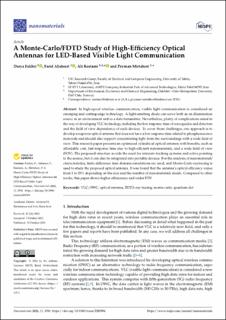| dc.contributor.author | Fakhri, Darya | |
| dc.contributor.author | Alidoust, Farid | |
| dc.contributor.author | Rostami, Ali | |
| dc.contributor.author | Mirtaheri, Peyman | |
| dc.date.accessioned | 2023-02-21T13:17:26Z | |
| dc.date.available | 2023-02-21T13:17:26Z | |
| dc.date.created | 2022-11-29T09:35:44Z | |
| dc.date.issued | 2022-10-13 | |
| dc.identifier.citation | Nanomaterials. 2022, 12 (20), . | en_US |
| dc.identifier.issn | 2079-4991 | |
| dc.identifier.uri | https://hdl.handle.net/11250/3052790 | |
| dc.description.abstract | In high-speed wireless communication, visible light communication is considered an emerging and cutting-edge technology. A light-emitting diode can serve both as an illumination source in an environment and as a data transmitter. Nevertheless, plenty of complications stand in the way of developing VLC technology, including the low response time of waveguides and detectors and the field of view dependence of such devices. To cover those challenges, one approach is to develop a superior optical antenna that does not have a low response time related to phosphorescence materials and should also support concentrating light from the surroundings with a wide field of view. This research paper presents an optimized cylindrical optical antenna with benefits, such as affordable cost, fast response time due to high-efficient nanomaterials, and a wide field of view (FOV). The proposed structure avoids the need for intricate tracking systems and active pointing to the source, but it can also be integrated into portable devices. For the analysis of nanomaterials’ characteristics, finite difference time domain simulations are used, and Monte-Carlo raytracing is used to study the proposed optical antenna. It was found that the antenna’s optical efficiency varies from 1 to 29% depending on the size and the number of nanomaterials inside. Compared to other works, this paper shows higher efficiencies and wider FOV. | en_US |
| dc.language.iso | eng | en_US |
| dc.publisher | MDPI | en_US |
| dc.relation.ispartofseries | Nanomaterials;Volume 12 / Issue 20 | |
| dc.rights | Navngivelse 4.0 Internasjonal | * |
| dc.rights.uri | http://creativecommons.org/licenses/by/4.0/deed.no | * |
| dc.title | A Monte-Carlo/FDTD Study of High-Efficiency Optical Antennas for LED-Based Visible Light Communication | en_US |
| dc.type | Peer reviewed | en_US |
| dc.type | Journal article | en_US |
| dc.description.version | publishedVersion | en_US |
| dc.rights.holder | © 2022 by the authors | en_US |
| cristin.ispublished | true | |
| cristin.fulltext | original | |
| cristin.qualitycode | 1 | |
| dc.identifier.doi | https://doi.org/10.3390/nano12203594 | |
| dc.identifier.cristin | 2083462 | |
| dc.source.journal | Nanomaterials | en_US |
| dc.source.volume | 12 | en_US |
| dc.source.issue | 20 | en_US |
| dc.source.pagenumber | 20 | en_US |

